This post may contain affiliate links. Please read our disclosure policy.
This vegetarian stuffing recipe is perfect to serve with your turkey for Thanksgiving. Made with roasted vegetables and fresh herbs, this stuffing recipe is also dairy free and vegan. Forget the boxed stuff this year, this flavorful vegetarian stuffing is sure to be a hit with everyone!

If you’re anything like me, when it comes to Thanksgiving, I’m all about the side dishes! And for those of you stressing about what to serve your vegetarian or vegan friends for Thanksgiving (or if you’re the vegan host), this stuffing casserole with no meat is a solid choice. It’s got layers of flavor thanks to the mix of vegetables and herbs, and a crispy edge with a soft center that’s totally irresistible – just like traditional stuffing.
Another thing I love about this recipe is that it uses hardened bread, something that almost everyone has on their counter. No need to get fresh bread or bake one. Simple, right? So let’s give it a try!
Table of Contents
- Recipe at a glance
- Ingredients to make vegetarian stuffing
- How to make vegetarian stuffing
- Tips for making the best vegetarian stuffing
- Popular substitutions & additions
- How to store & reheat vegetarian stuffing
- Popular substitutions & additions
- How to store & reheat vegetarian stuffing
- Frequently asked questions
- More Thanksgiving side dishes:
- Vegetarian Stuffing Recipe
Recipe at a glance
Cuisine Inspiration: American
Primary Cooking Method: Oven
Dietary Info: Dairy-Free, Vegan
Key Flavor: Savory, Earthy
Skill Level: Easy
Summary
- Very Forgiving: You can add more or less vegetables or herbs depending on your taste. You don’t have to follow the exact recipe.
- Simple yet Flavorful: This stuffing doesn’t need drippings, meat broth or fancy ingredients to be tasty. The vegetables give it all the flavor.
- Versatile. You can make this side dish for other holidays, gatherings or for whenever you want a good healthy vegetarian stuffing.
- Healthy-ish. Packed with vitamins A, C, and K from the veggies and the apples, this stuffing not only warms the heart but also nourishes the body.
Ingredients to make vegetarian stuffing
- Sourdough bread: Using almost stale sourdough bread is the way to go. But if sourdough is not your thing, swap it out with any hearty bread you’ve got.
- Onion, celery, and butternut squash: These veggies are the heart of the vegetarian stuffing casserole. They bring in texture and earthiness. Instead of butternut squash, you can use carrots or other types of winter squashes like acorn squash. Also, instead of celery, you can use fennel.
- Apples: Use firm apples like Granny Smith or Honeycrisp. They keep their shape well and add a great sweetness contrast.
- Parsnip (optional): If you have it, you can add it to your stuffing for a subtle sweet and earthy flavor.
- Fresh thyme, sage, and parsley: These herbs bring the aromas and flavors we all associate with cozy holiday meals.
- Olive oil: For roasting the vegetables. You can also use your favorite cooking oil.
- Salt and black pepper: To bring everything together. Adjust to taste.
Vegetable broth: It helps moisten the stuffing and bind all the flavors together.
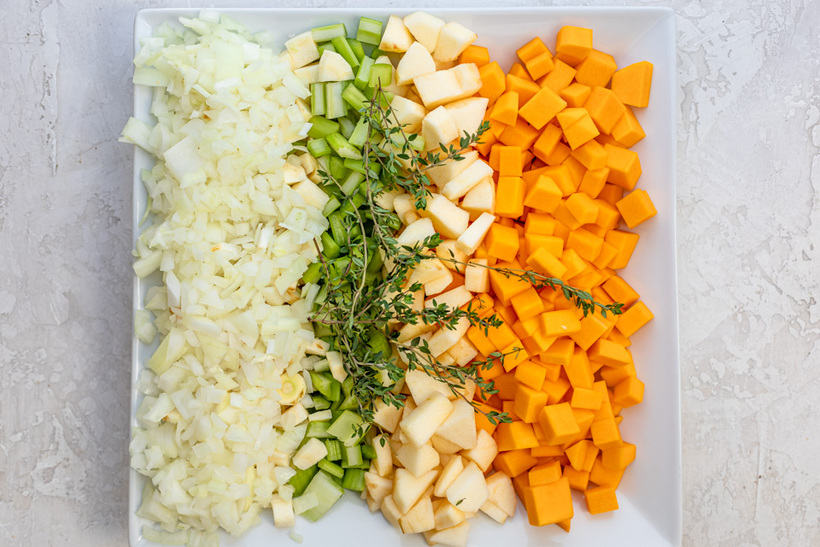
How to make vegetarian stuffing
Cut the bread and roast
You want to get a large loaf of sourdough bread a few days before baking and leave it out on the countertop. That will ensure that the bread is not too fresh and soft, but hardened and almost stale. Cut into bite sized piece and spread apart on baking dish.
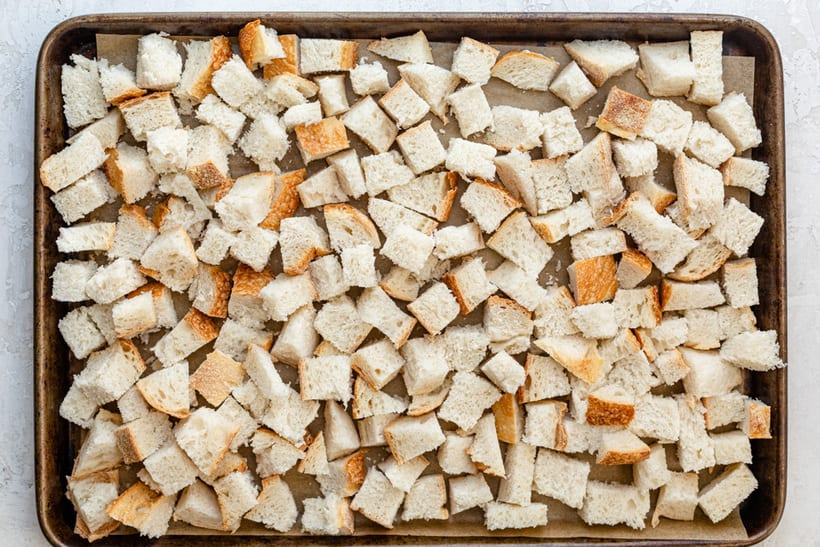
When it comes out of the oven, you want to to check that the bread has hardened and become golden brown and crunchy. Let it sit aside when it’s done to continue drying.
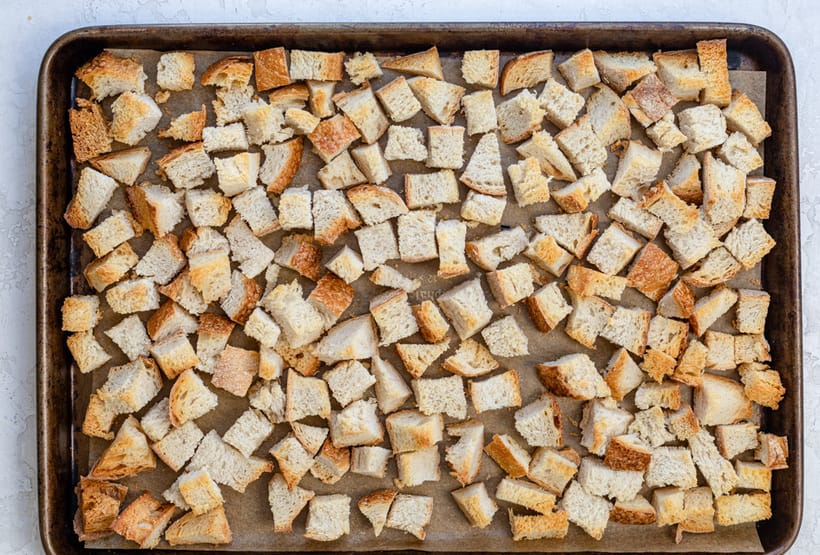
Prepare the vegetables
Next it’s time to roast the vegetables. I recommend using the casserole dish you’ll be serving the stuffing in. Toss vegetables with apples and herbs and seasoning and roast in the preheated oven. It’s ok if the bread is still in there, although I would recommend finishing the bread before roasting the vegetables so it doesn’t impact the moisture in the oven.
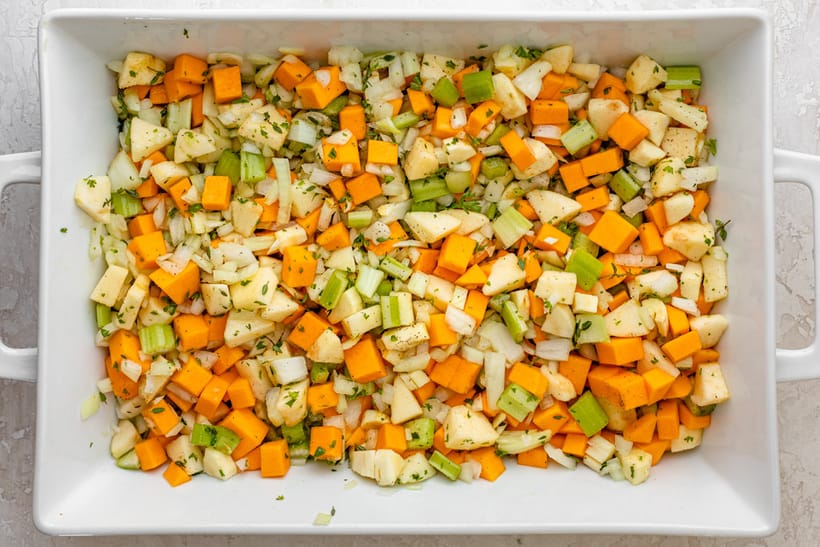
When it comes out of the oven, transfer the toasted bread on top of the roasted vegetables and add the vegetable broth. Mix everything together so the broth soaks all the ingredients well. Then return the vegetarian stuffing to the oven, first covered with tin foil, and then uncovered until the broth is absorbed and the bread is toasted.
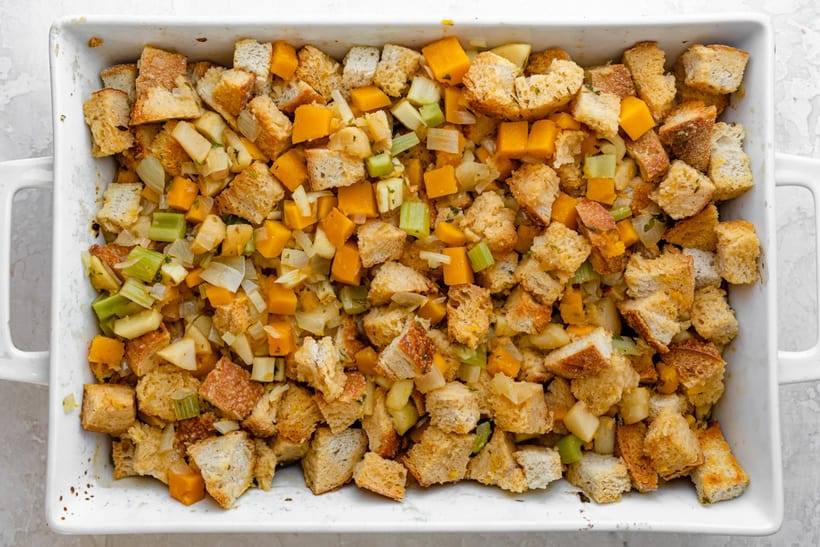
Tips for making the best vegetarian stuffing
- Use stale bread and make sure to completely dry out the bread. It helps to absorb moisture from the broth and vegetables while staying crunchy. If you try to make any turkey stuffing recipe with soft, fresh bread, it results in a soggy texture.
- Use fresh herbs. While you can substitute every tablespoon of fresh herbs for one teaspoon of dried herbs, this is the time of year to use those poultry herbs that are stocked at grocery stores. I love the combination of thyme and parsley. But you can also use sage and rosemary in addition or instead.
- Cut all the vegetables into small bite sized pieces. When you take a bite of stuffing, you want to get the full aromatics in each bite plus the soaked and toasted bread. Cutting everything small and uniform helps the stuffing roast evenly and yield a consistent flavor throughout.
- Make sure to cook the aromatics before. This includes onions and celery. True they’ll cook with the bread, but they need to cook first on their own to release the best flavor.
- Toast the bread in advance. If you’re short on time, toast the bread cubes the night before to speed up the baking process of your vegetarian stuffing casserole. By the next day they will be ready to soak up all the flavors!
Popular substitutions & additions
- Vary the Herbs: While sage, thyme, and parsley are classics, consider switching things up with rosemary, basil, or even a pinch of dill. Play around and see what flavors you like!
- Add Some Nuts: For an extra crunch, toss in a handful of your favorite nuts. Walnuts, pecans, or slivered almonds are good options.
- Make it Gluten-Free: Swap sourdough bread for any gluten-free bread you like.
- Add Dried Fruit: Could be dried cranberries, raisins, or apricots. Perfect for when you like your vegetarian stuffing a bit sweeter.
How to store & reheat vegetarian stuffing
After letting the stuffing cool to room temperature, transfer it to an airtight container and store it in the refrigerator.
To reheat your vegetarian stuffing casserole, preheat the oven to 350°F. Spread the stuffing in an even layer in a baking dish and cover it with aluminum foil. Then, place it in the oven for about 5-10 minutes or until heated through. If you want a quicker method, you can also use a microwave, heating in short intervals and stirring in between until warm.
How long will this
Popular substitutions & additions
- Vary the Herbs: While sage, thyme, and parsley are classics, consider switching things up with rosemary, basil, or even a pinch of dill. Play around and see what flavors you like!
- Add Some Nuts: For an extra crunch, toss in a handful of your favorite nuts. Walnuts, pecans, or slivered almonds are good options.
- Make it Gluten-Free: Swap sourdough bread for any gluten-free bread you like.
- Add Dried Fruit: Could be dried cranberries, raisins, or apricots. Perfect for when you like your vegetarian stuffing a bit sweeter.
How to store & reheat vegetarian stuffing
After letting the stuffing cool to room temperature, transfer it to an airtight container and store it in the refrigerator.
To reheat your vegetarian stuffing casserole, preheat the oven to 350°F. Spread the stuffing in an even layer in a baking dish and cover it with aluminum foil. Then, place it in the oven for about 5-10 minutes or until heated through. If you want a quicker method, you can also use a microwave, heating in short intervals and stirring in between until warm.
How long will this vegetarian stuffing last in the fridge?
This stuffing will last in the fridge for about 4-5 days, but the consistency is best on the first day.
Can I freeze this easy vegetarian stuffing?
You can! First, let the stuffing cool completely. Then, transfer it to a freezer-safe container or freezer bag, pressing out as much air as possible. Seal it tightly, and store it in the fridge for up to 3 months.
Frequently asked questions
If your stuffing turns out dry, you can drizzle some warmed vegetable broth over the top and bake for another 5-10 minutes. It’ll soak up the extra moisture.
You can make stuffing a day or two ahead of time. Add the stock, but don’t add the bread and don’t bake it. Cover it and keep it in the fridge, then add the toasted dried bread and bake it on the day. You can also bake it slightly ahead of time and then cover it with foil and heat through before serving. Leftovers should be stored in an airtight container in the fridge.
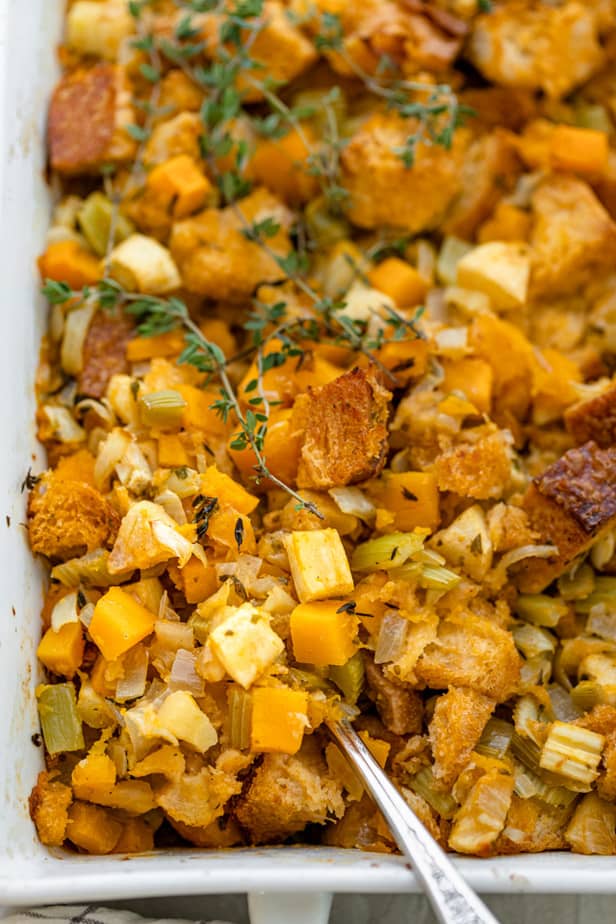
More Thanksgiving side dishes:
- Thanksgiving Stuffing
- Roasted Garlic Mashed Potatoes
- Melting Sweet Potatoes
- Garlic Roasted Potatoes
- Butternut Squash Mac and Cheese
- Holiday Brussels Sprouts
- Healthy Mashed Potatoes
- Cauliflower Au Gratin
- Oven Roasted Carrots
- Air Fryer Brussels Sprouts
Add this delicious vegetarian stuffing to your Thanksgiving or Christmas holiday dinner. The butternut squash and apples are a pleasant surprise that brings a warm and sweet taste to the recipe. The recipe is egg-free and dairy-free but full of flavor that’s perfect with turkey!
If you’ve tried this healthy-ish feel good Vegetarian Stuffing recipe or any other recipe on FeelGoodFoodie, then don’t forget to rate the recipe and leave me a comment below! I would love to hear about your experience making it. And if you snapped some shots of it, share it with me on Instagram so I can repost on my stories!
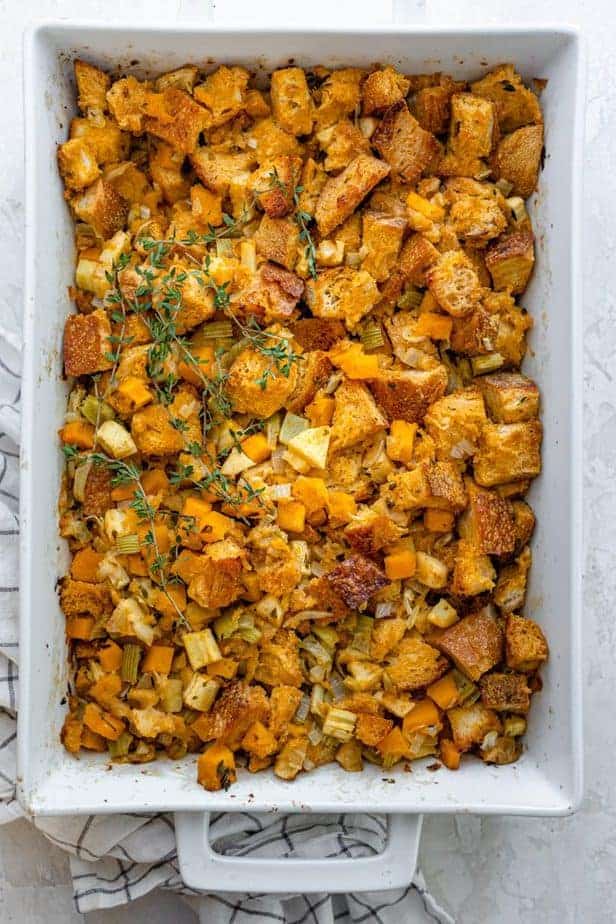
Vegetarian Stuffing
Video
Ingredients
- 12 slices stale sourdough bread 14 ounces, cubed
- 1 onion chopped
- 3 celery sticks chopped
- ½ butternut squash peeled, seeded and chopped
- 3 apples chopped
- 1 parsnip chopped (optional)
- 4 sprigs fresh thyme destemmed and chopped
- 4 sage leaves chopped
- 1 ½ tablespoons fresh parsley chopped
- 3 tablespoons olive oil
- ½ teaspoon salt
- ¼ teaspoon black pepper
- 4 cups vegetable broth
Instructions
- Preheat oven to 400°F. Place the cubed bread on a baking tray and toast in the oven until it dries out but does not get browned, about 15-20 minutes; set aside at room temperature.
- In another 9×13 baking dish, toss the onions, celery, parsnip, butternut squash, apples, thyme, sage and parsley with olive oil, salt and pepper. Bake in the pre-heated oven until the vegetables soften, about 35-40 minutes.
- Remove the baking dish from the oven, add bread on top and pour the vegetable broth over. Mix until all the broth has been absorbed. Press the mixture with the back of the spoon to level it off.
- Bake uncovered until the stuffing begins to brown, about 30 minutes. Toss mixture and bake for an additional 30 minutes until some of the bread is toasted. Allow the stuffing to cool for 5-10 minutes and serve.
Notes
- To make it gluten-free, you can use any gluten-free bread of your choice.
- Instead of butternut squash, you can use carrots or other types of winter squashes like acorn squash.
- Instead of celery, you can use fennel.
- Feel free to vary the herbs to your taste.
Nutrition
Nutrition information provided is an estimate. It will vary based on cooking method and specific ingredients used.

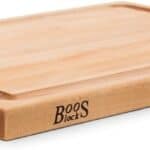
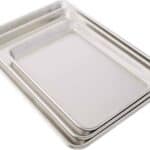
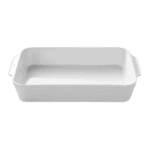
I can hardly wait until I try this stuffing recipe this week, this sounds so good.
Thank you for all the recipes.
Roman
I’m so excited for you to try it! Happy to have shared!
Hi Yumna your recipes sound delicious & healthy I have a friend who’s Lebanese he would love these dishes me too I’ll have to try them thanks for sharing 🤗
Thank you so much! Hope you love all of the recipes!
Love stuffing. I took your advice to roast the vegetables aside then add the toasted bread. Good tips. Will be a repeat on thanksgiving.
Yay! Glad to hear it!!